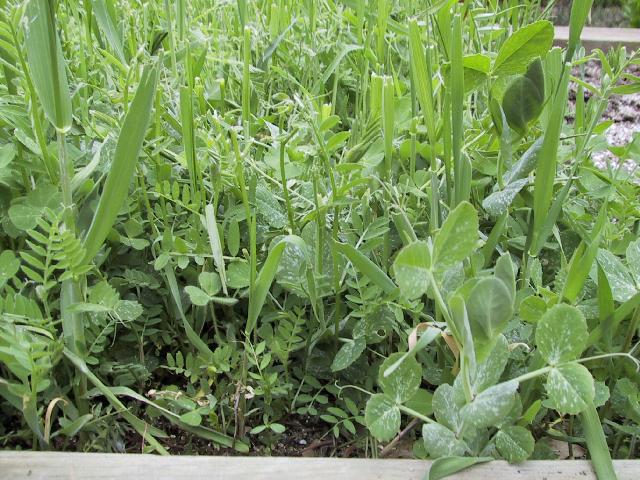Protect and Enrich Your Soil with Cover Crops…
Ask any seasoned gardener for their best soil improvement tip and many of them will say, “Use a cover crop to protect and enrich your soil.”
We know about enriching soil with compost and deep mulch, but many new gardeners haven’t thought much about the benefits of using a cover crop.
The Benefits Of Cover Crops For Your Soil…
Bare soil is a no-no! After harvest it’s super important to protect your already tired soil from runoff and nutrient depletion. A friend of mine, who is a champion for cover crops says, “NO BARE SOIL!” She kinda gets on a soap box about it.
Here are some of benefits your soil gets from a good cover crop:
• Organic matter is increased
• Nitrogen is fixed in the soil
• Soil erosion is halted and prevented
• Often provides food for pollinating insects
• Loosens subsoil allowing for aeration which means healthier root systems and healthier plants
• Draws minerals and other nutrients up for easy access
• Keeps moisture in the soil
How to Use Cover Crops in Your Garden…
Buckwheat seems to be the favorite cover crop of our day. It grows well in most climates. My friends down south plant it, let it go to seed, and it comes up again for a second time. Before it goes to seed a second time, they cut it down and incorporate it as green manure. It’s a pretty smart way to work magic for your soil in preparation for next year’s crops.
If you don’t have a long enough season to let it come up twice, just cut it down after it blooms, but before it goes to seed. Its beautiful, fragrant flowers will also provide food for the millions of pollinators who need the nectar to prepare for winter.
As your cover crop dies, the roots dry up. This decay process allows for deep penetration of oxygen and water. Not only will your future plants love you for it, all those millions of little microbes will thrive and work for you!
Choosing the Best Cover Crops…
You’re not bound by planting one crop. You can mix and match any cover crops which will grow in your area. I like to mix buckwheat and clover. While the buckwheat adds heaps of biomass, the clover fixes nitrogen. The nitrogen fixed by the clover breaks down the carbon that is so abundant in the buckwheat root. What a win-win! Working together, they have just given next year’s garden a huge boost.
It was George Washington Carver who said, “Always leave the soil in a better condition than when you found it.” He was a smart man, and this technique definitely helps to keep your soil healthy and strong.
Now don’t get me wrong, cover crops are not just for your vegetable garden. Some people plant them in their fruit orchards. Many perennial flower gardens also do well planted in low growing cover crops like clover.
You’ll have to decide which crops you want to plant, based on which do best in your region and what your soil needs. There are two classes of cover crops you should know about when you start out.
Two Classes of Cover Crops…
Grains
Some grains make great cover crops. They have extensive root systems which add huge amounts of biomass to the soil. Most of them aren’t as cold tolerant as the legumes I mention below.
Examples: Rye grass (annual), wheat grass (good for every living thing to eat), winter rye, and winter wheat.
Legumes
Legumes make great cover crops because they fix nitrogen in the soil and can tolerate cold better than grains. Planting peas where you have grown corn is the best way to replace the nitrogen that has been depleted from the area by the corn.
Examples: Austrian winter pea, purple vetch (all vetch), crimson clover (all clovers), peas, peanuts, and beans.
You can get a great result by swapping between these two classes, or by companion planting these two classes together. They can work together to keep your soil protected pretty much all year round.
Cover Crops for Cool Weather…
These cool weather cover crops will grow quickly during the cool days of fall and early winter. When freezing temperatures arrive, they will die off, leaving their stalks and leaves to protect the soil as mulch.
Common Cool Weather Cover Crops
• Annual rye grasses
• Winter wheat
• Vetches
• Clovers
• Winter peas
• Barley
• Oats
• Peanuts
I should probably mention that it’s not a good idea to plant a cool weather cover crop when the daytime temps are still above 80. They’ll likely die, or be stunted at best. Be sure to check your local average temperatures against the requirements for the cover crops you’re planting.
Cover Crops for Warm Weather…
Just like you’d think, a warm weather cover crop will not do well in cold weather. In freezing temperatures they won’t even sprout. Ideally, they should not be sown until a week or two after the last spring frost. For the best results, daytime temperatures should consistently be in the 60s.
Common Warm Weather Cover Crops
• Soybeans (please choose a non-GMO variety)
• Buckwheat
• Millets
• Sorghum
• Peas
• Beans
So there you have it, all you need to know about cover crops. So what are you waiting for? Get gardening. There’s always something to do out there. Want more great gardening advice? Check out…
Growing Your Own Groceries
If you like this idea, be sure to share it with your friends and inspire someone you know. Anything becomes possible with just a little inspiration…

